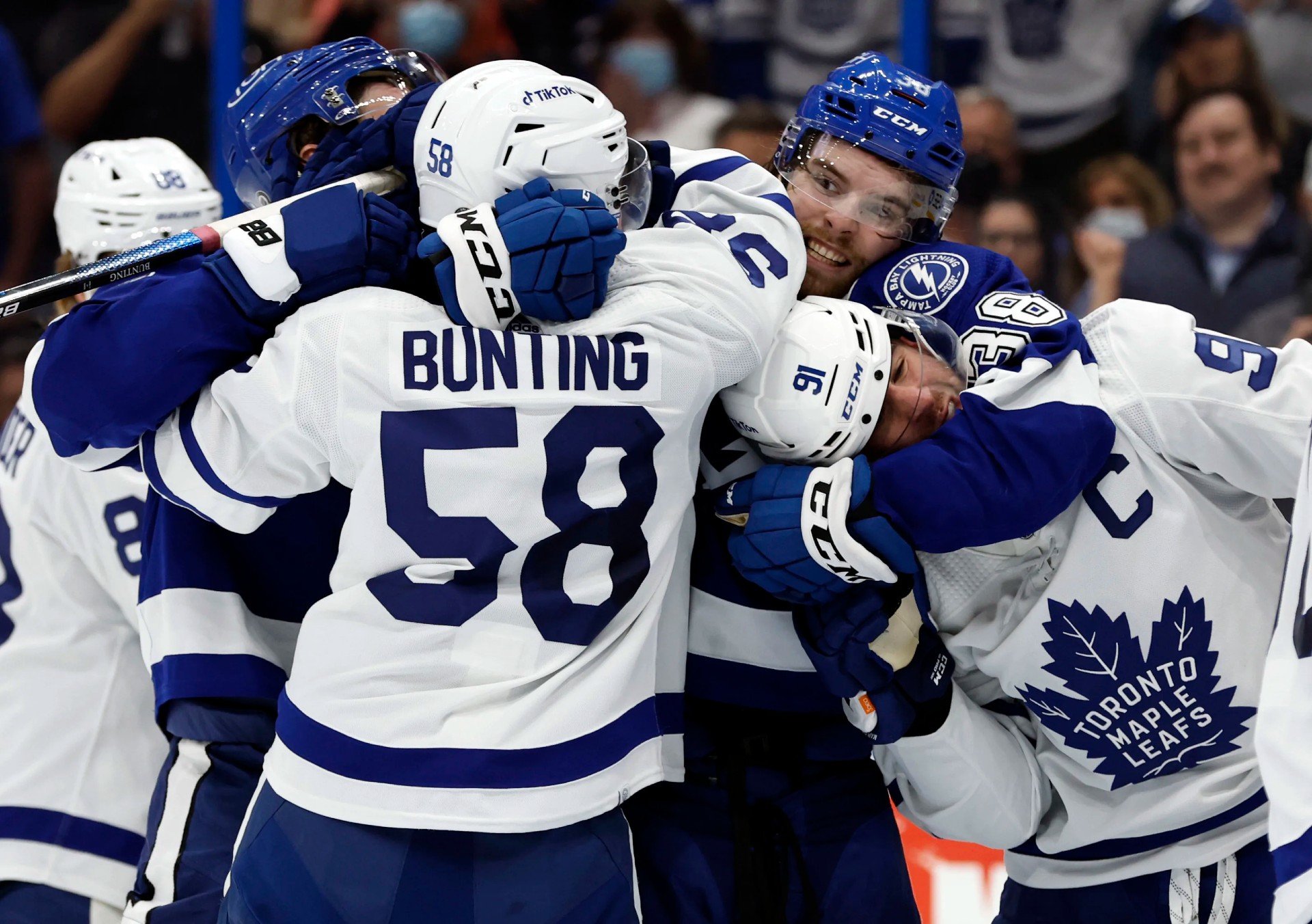A suspension at playoff time is clockwork at this point for the Maple Leafs.
For the Leafs, the last 24 hours have included a really tough Game 1 loss and now a suspended player. Time is indeed a flat circle when it comes to this team and the postseason.
The ruling on Bunting’s illegal check to the head is three games, or as we’re told, the equivalent of six regular-season games. Knowing the Department of Player Safety is applying some kind of multiplier in the playoffs, this makes this the most egregious suspendable offense of the entire 2022-23 NHL season so far according to the league.
The NHL has issued 21 suspensions this season, the longest being three games — Nicolas Aube-Kubel’s illegal check to the head on Cal Foote, Jeff Skinner’s high-sticking of Jake Guentzel, and K’Andre Miller’s spitting incident involving Drew Doughty. Bunting’s suspension of three playoff games, therefore, makes this the harshest punishment handed out this year.
In a month when Minnesota’s Ryan Hartman — who has a suspension history dating back to an illegal hit to the head on Gabriel Landeskog in the 2018 playoffs — received one regular-season game for his interference infraction on Nik Ehlers (who missed time), it seems disproportionate, while still recognizing Bunting’s hit deserved more games for more clearly/principally targeting the head.
The equivalent of five more games for a player with no history, though? Bunting absolutely deserved supplemental discipline for a needless, reckless play away from the puck that caused an injury to Cernak, but it doesn’t add up.
The DoPS’ logic:
Tuesday night in Toronto, Maple Leafs forward Michael Bunting was assessed a match penalty for an illegal check to the head of Lightning defenseman Erik Cernak, causing an injury.
As the video shows, the Maple Leafs win a faceoff and take a shot toward the goal that bounces into the corner. Bunting and Cernak turn to locate the puck, with Bunting slightly ahead of Cernak.
As the puck wraps around the net, Bunting cuts back into Cernak, elevating significantly into the contact and picking his head, making it the main point of contact on a hit where such head contact was avoidable.
This is both an illegal check to the head and interference. It is important to note that both elements of the illegal check to the head rule are satisfied on this play.
First, the head is clearly the main point of contact. Bunting’s upper arm and elbow make forceful and direct contact with the head of Cernak. It is the head that absorbs nearly all of the force of the check.
Second, the head contact on the play is avoidable. Bunting unnecessarily extends his body upward into Cernak’s head to deliver this check, missing his core completely and picking the head.
It is also important to note that this is also interference. Cernak is never in possession of the puck during the sequence. Therefore, he should have no reason to expect to be checked, making him particularly vulnerable.
This is also not a case in which two players approaching a puck simultaneously are mutually prepared for contact to occur as they battle for space. The puck is some distance from both players when contact is initiated by Bunting.
This is an illegal check to the head delivered to a player who has no reason to anticipate any contact, let alone contact with sufficient force to cause an injury.
To summarize:
– This is an illegal check to the head and interference
– Cernak suffered an injury on the play
– Bunting has been neither fined nor suspended previously in his 187-game NHL career.
The Department of Player Safety has suspended Michael Bunting for three playoff games.
Bunting gets the boot for this hit https://t.co/PBVtnu3QZn
— Spittin' Chiclets (@spittinchiclets) April 19, 2023
The lineup adjustment for the Leafs will almost certainly involve rookie Matthew Knies entering the lineup, and Calle Jarnkrok elevating to the top line. Many will reasonably argue this should’ve been the team’s top line from the beginning of Game 1 — and Jarnkrok scored on that line in the third period after Bunting was ejected.
It is also fair to point out that Bunting has become a penalty liability — certainly more prone to losing his composure this season, clearly firmly on the officials’ naughty list, and seemingly a little lost as to how to toe the line properly — while producing much less than expected of late with seven points in his last 22 games.
That said, the hit to the team’s forward depth will be felt unless Knies can hit the ground running coming off of his three regular-season games. Bunting has been a 20+ goal scorer in each of his two seasons with the Leafs. He chipped in three points in six games in last year’s playoff series. When he is actually producing, he tends to score his goals in the tougher areas of the ice where the Leafs struggled to penetrate offensively at five-on-five in Game 1.
The Leafs’ bottom six was described as having a tough Game 1 by Sheldon Keefe last night; combine this suspension with a rough Game 1 for the Alex Kerfoot – Noel Acciari – Jarnkork line, and it appears they may need to lend Ryan O’Reilly to the third-line center position now. This has the tradeoff of creating a Kerfoot – Tavares – Nylander second line that has not been an overly convincing trio over the years; as a three-man unit, they’ve scored 28 goals and allowed 28 goals at five-on-five over the last two seasons.
It brings into the discussion whether the right adjustment is to lend Mitch Marner to the Tavares line if Game 2 isn’t going the Leafs’ way early. It’s gone under-discussed just how dominant Matthews – Nylander were together this past regular season, out-scoring the opposition by a whopping 38-14 margin at five-on-five. Theoretically, it could make the Leafs a more dangerous team overall and a tougher matchup proposition if there is little drop-off between Matthews-Nylander vs. Matthews-Marner while elevating the second line with Marner’s presence.
As much as Bunting hasn’t been a particularly effective contributor of late, the net impact of this suspension isn’t nothing, although the talent and upside of Knies are enough to be somewhat hopeful that this could swing into a positive development for the Leafs (so is the possibility of ROR elevating a third line that was a non-factor in Game 1, to state it mildly). It’s just hard to totally bank on it with Knies.
Alas, it’s the playoffs in Toronto. It was never going to be easy.
The other side of this matchup is facing some challenges of their own coming out of Game 1, with Cernak knocked out of Game 2 and Victor Hedman questionable to play on a blue line that is already relying on two rookies to play pretty substantial roles. They survived 1-2 periods without Cernak and Hedman last night, but that was with the buffer of a significant lead against a Leafs team playing well below its usual standard.
The sequence of five-on-five hockey to start the second period with Tampa sans Hedman looked a lot more like how many of us pictured this series going as the Leafs started to attack in waves and overwhelm the Lightning. There are vulnerabilities to exploit if the Leafs can find their rhythm with the puck that eluded them early on and was then disrupted by the chaos of the officiating decisions and Bunting’s selfish misdeed in the second period.
Who responds best to their own type of adversity in Game 2 is going to go a long way to deciding this series.



![Sheldon Keefe on the Maple Leafs’ struggling power play: “[We’ve scored] one out of 11 high-danger chances in tight to the net… We have been in those spots and haven’t converted” Sheldon Keefe, playoff press conference](https://mapleleafshotstove.com/wp-content/uploads/2024/04/keefe-pc-game-3-218x150.jpg)

![Jim Montgomery Post Game, Bruins 4 vs. Leafs 2: “[Marchand] still manages to get under people’s skin, yet he doesn’t cross the line” Jim Montgomery, Boston Bruins post game](https://mapleleafshotstove.com/wp-content/uploads/2024/04/jim-monty-pg-to-218x150.jpg)
























![Sheldon Keefe on the Maple Leafs’ struggling power play: “[We’ve scored] one out of 11 high-danger chances in tight to the net… We have been in those spots and haven’t converted” Sheldon Keefe, playoff press conference](https://mapleleafshotstove.com/wp-content/uploads/2024/04/keefe-pc-game-3-100x70.jpg)



![Jim Montgomery Post Game, Bruins 4 vs. Leafs 2: “[Marchand] still manages to get under people’s skin, yet he doesn’t cross the line” Jim Montgomery, Boston Bruins post game](https://mapleleafshotstove.com/wp-content/uploads/2024/04/jim-monty-pg-to-100x70.jpg)
